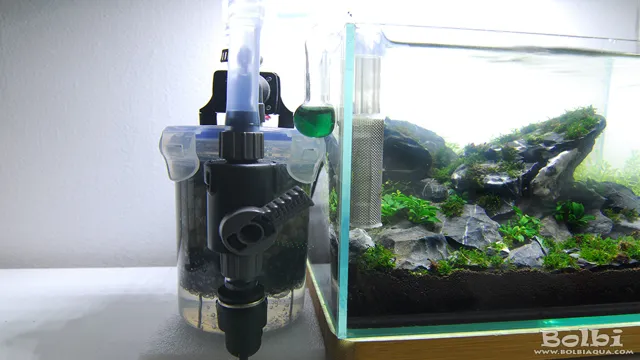Is your freshwater aquarium suffering from a bacterial bloom? You may have noticed cloudy water or an excess of algae growth. Don’t panic – this is a common issue in aquariums, and there are plenty of ways to fix it. Bacterial blooms occur when there is an overabundance of organic matter in the tank, leading to an increase in bacteria that consume it.
While the bacteria aren’t necessarily harmful, they can cause unsightly water conditions and harm fish and plant life if left unchecked. In this blog post, we’ll explore the causes and symptoms of bacterial blooms and provide you with practical solutions to get your aquarium back on track. So, grab a cup of coffee and let’s dive in!
Introduction
If you notice a bacterial bloom in your freshwater aquarium, don’t panic – there are steps you can take to fix the situation. First, test the water parameters to ensure they are within the appropriate range for your fish and plants. If the levels are off, do a partial water change and adjust accordingly.
Next, reduce the amount of food you are feeding your fish and avoid overfeeding. This will help to decrease the amount of excess nutrients in the water. Consider adding some live plants to the aquarium as they can help absorb excess nutrients and reduce the growth of bacteria.
Finally, if necessary, you can add a bacterial supplement to help establish a healthy microbial balance in the tank. By following these steps and monitoring the water parameters regularly, you can address and prevent bacterial blooms in your freshwater aquarium.
What is Bacterial Bloom
Bacterial blooms are a common phenomenon in the aquatic world and refer to sudden, explosive increases in the population of bacteria in a body of water. These blooms often occur when an excess of nutrients, such as nitrogen and phosphorus, are present in the water, leading to an overgrowth of bacterial populations. This surge in bacteria can cause discoloration of the water, foul odors, and can also have negative impacts on aquatic life.
Bacterial blooms can be harmful to humans, too, as they may harbor harmful bacteria that can cause illnesses or infections. It’s important to note that bacterial blooms are different from harmful algal blooms, which can also occur in bodies of water and are caused by the rapid growth of algae. To prevent bacterial blooms, it’s essential to monitor nutrient levels in the water and take steps to reduce excess amounts.

Why It Happens
“Why it happens” is a common question we ask ourselves when we encounter unexpected situations. Whether it’s a health problem, a work complication, or a relationship issue, we tend to seek answers as to why it happened. In most cases, the answer is not always straightforward.
Many factors contribute to the situation’s occurrence, and identifying them can be challenging. Nonetheless, understanding the underlying reasons can help us accept the situation and take necessary steps to prevent a recurrence. So, why does it happen? The keyword “cause” comes to mind.
Identifying the cause is the first step to understanding why things happen. It could be a combination of biological, environmental, or circumstantial factors that is behind the situation’s occurrence. By identifying the cause, we can take steps to eliminate or mitigate the issue’s impact.
Steps to Fix a Bacterial Bloom
If you’ve noticed cloudy water, a foul smell, or an increase in algae growth, you may be dealing with a bacterial bloom in your freshwater aquarium. The good news is that it is fixable. The first step is to test the water quality to determine the cause of the bloom.
High levels of waste, excess food, or overstocking could be the culprits. Next, consider a water change to dilute the toxins in the water. You can also increase water circulation and aeration to combat low oxygen levels, which can encourage bacterial growth. (See Also: How to Dress Up Aquarium Stand with Creative Décor Ideas on a Budget)
Regular maintenance and cleaning can also help prevent future blooms. Using a bacterial supplement can also help establish a healthy bacteria population to outcompete the harmful bacteria. Remember, patience is key in fixing a bacterial bloom.
A sudden change could shock your fish and cause more harm than good.
Remove debris and excess nutrients
One of the best ways to fix a bacterial bloom in your aquatic ecosystem is by removing debris and excess nutrients. When there is too much organic matter in the water, such as leaves, fish food, and waste, it can cause a spike in the nutrients that bacteria feed on. To fix this issue, start with a thorough cleaning of the tank or pond, removing any decaying plant matter or uneaten food.
You can also add beneficial bacteria products to help lower nutrient levels and restore balance. Additionally, consider reducing the amount of food you give your fish and doing partial water changes more frequently to remove excess nutrients from the water. By taking these steps, you can help prevent and fix bacterial blooms in your aquatic ecosystem, ensuring a healthier and more balanced environment for your fish to thrive in.
Increase aeration and water flow
Bacterial blooms can be a cause for concern in aquariums, but there are steps you can take to fix the issue. One of the most important things is to increase aeration and water flow in your tank. This can be done by adding an air pump or powerhead, or by adjusting the flow rate of your filter.
By increasing oxygen levels and creating more movement in the water, beneficial bacteria can thrive and compete with harmful bacteria, reducing the risk of a bacterial bloom. Additionally, regularly testing your water parameters and doing partial water changes can help maintain a healthy environment for your aquatic pets. Remember, prevention is key, but if you do experience a bacterial bloom, don’t panic.
Follow these steps and monitor your tank closely to ensure a healthy and happy aquarium.
Water changes and vacuuming
If you’re experiencing a bacterial bloom in your aquarium, don’t worry! There are steps you can take to fix the problem. One of the first things you should do is a water change. This involves removing a portion of the water in your tank and replacing it with fresh, dechlorinated water.
Aim to change about 25% of the water each time to avoid disrupting your fish too much. At the same time, use a vacuum to clean the gravel or substrate in your tank. This will help remove any excess food or waste that may be contributing to the bacterial bloom.
Repeat this process once a week until the bloom is under control. Remember to check your water parameters regularly to make sure they are stable. Overall, with a little patience and persistence, you can successfully fix a bacterial bloom in your aquarium.
Medical Treatments
If you’re experiencing a bacterial bloom, the good news is that there are steps you can take to fix the problem. First and foremost, it’s important to identify the source of the bloom. This could be due to overfeeding, an overstocked tank, or poor water quality. (See Also: How to Calculate Total Flow Rate Aquarium: A Beginner’s Guide to Optimal Water Exchange)
Once you’ve identified the cause, you can take action to address it. This may involve reducing the amount of food you feed your fish or performing more frequent water changes. Additionally, adding an aquarium salt solution or using a beneficial bacteria supplement can help to restore the balance of your tank’s ecosystem.
Remember, a bacterial bloom can be a sign of underlying issues, so it’s important to address the root cause, not just the symptoms. With a little effort, you can get your tank back on track and enjoy a healthy, thriving aquatic environment.
Preventing Bacterial Bloom
If you’re dealing with a bacterial bloom in your freshwater aquarium, don’t panic! There are a few simple steps you can take to fix the problem and prevent it from happening again. Firstly, check your water parameters to ensure they are within the appropriate range for your fish and plants. High levels of ammonia or nitrite can cause a bacterial bloom and harm your aquatic inhabitants.
Secondly, perform a water change to remove any excess nutrients in the water column. This can include uneaten food, fish waste, and decaying plant matter. Lastly, consider adding an aquarium UV sterilizer to your filtration system.
These devices use ultraviolet light to kill bacteria and other microorganisms in the water, preventing future blooms from occurring. With these steps, you can maintain a healthy and balanced aquatic environment for your fish and plants.
Avoid Overfeeding
When it comes to feeding your fish, it’s important to avoid overfeeding. Not only can excess food quickly foul up your tank’s water, but it can also lead to a bacterial bloom. Bacterial blooms occur when there is an abundance of organic material (like unconsumed food) in the water.
This abundance of nutrients stimulates the growth of bacteria, resulting in cloudy water and potentially harmful levels of ammonia and nitrite. To prevent bacterial blooms and maintain a healthy aquarium, it’s important to feed your fish in moderation. A good rule of thumb is to feed your fish small amounts two to three times a day, only giving them as much as they can consume in 2-3 minutes.
By avoiding overfeeding and maintaining proper water chemistry, you can help keep your fish happy and healthy.
Regular Cleaning
Regular cleaning is crucial in preventing bacterial blooms in your living space. In fact, it is one of the most effective ways to maintain a clean and healthy environment. Without regular cleaning, bacteria can multiply and spread quickly, which can lead to various illnesses and infections.
Cleaning regularly not only eliminates harmful bacteria but also helps to remove other types of contaminants like dust, dirt, and allergens. By using effective cleaning products and techniques, you can keep your home safe from harmful bacteria and create a healthy living space for you and your family. So, make sure to set up a routine for cleaning your home regularly and remember to use the appropriate cleaning products for each surface to ensure your home is free of harmful bacteria.
Conclusion
In summary, dealing with a bacterial bloom in your freshwater aquarium requires a combination of patience, diligence, and proper maintenance. The key is to identify the root cause of the problem and take the necessary steps to correct it. It’s important to always keep in mind that prevention is the best cure, so maintaining a healthy and balanced aquarium environment is crucial. (See Also: How to Convert a Saltwater Aquarium to Freshwater Aquarium – Complete Guide)
With these tips and tricks, you’ll be well on your way to reclaiming the clear and pristine waters of your aquarium. So, roll up your sleeves, hop to it, and show that bacterial bloom who’s boss!”
FAQs
What is a bacterial bloom in a freshwater aquarium?
A bacterial bloom is an overgrowth of bacteria in the water of a freshwater aquarium, causing cloudy or murky water.
What causes a bacterial bloom in a freshwater aquarium?
A bacterial bloom is often caused by an excess of decomposing organic matter, poor water filtration, overfeeding, or sudden changes in water chemistry.
Can a bacterial bloom harm fish in a freshwater aquarium?
A bacterial bloom may not directly harm fish, but it can reduce the amount of oxygen in the water and lead to stress for fish, making them more prone to disease.
How can I prevent a bacterial bloom in my freshwater aquarium?
Regular water changes, proper filtration, avoiding overfeeding and maintaining good water chemistry can prevent bacterial blooms in a freshwater aquarium.
How can I fix a bacterial bloom in my freshwater aquarium?
Fixing a bacterial bloom may involve removing excess organic matter and debris from the aquarium, increasing water change frequency, adding a bacterial remediation product, and adjusting water chemistry.
How long does it take to clear up a bacterial bloom in a freshwater aquarium?
Clearing up a bacterial bloom can take several days to a few weeks, depending on the severity of the bloom and how quickly corrective measures are taken.
Can a bacterial bloom reoccur in my freshwater aquarium?
Yes, a bacterial bloom can reoccur if the underlying causes are not addressed, such as poor water maintenance practices or overfeeding. Regular aquarium maintenance can help prevent future blooms.







